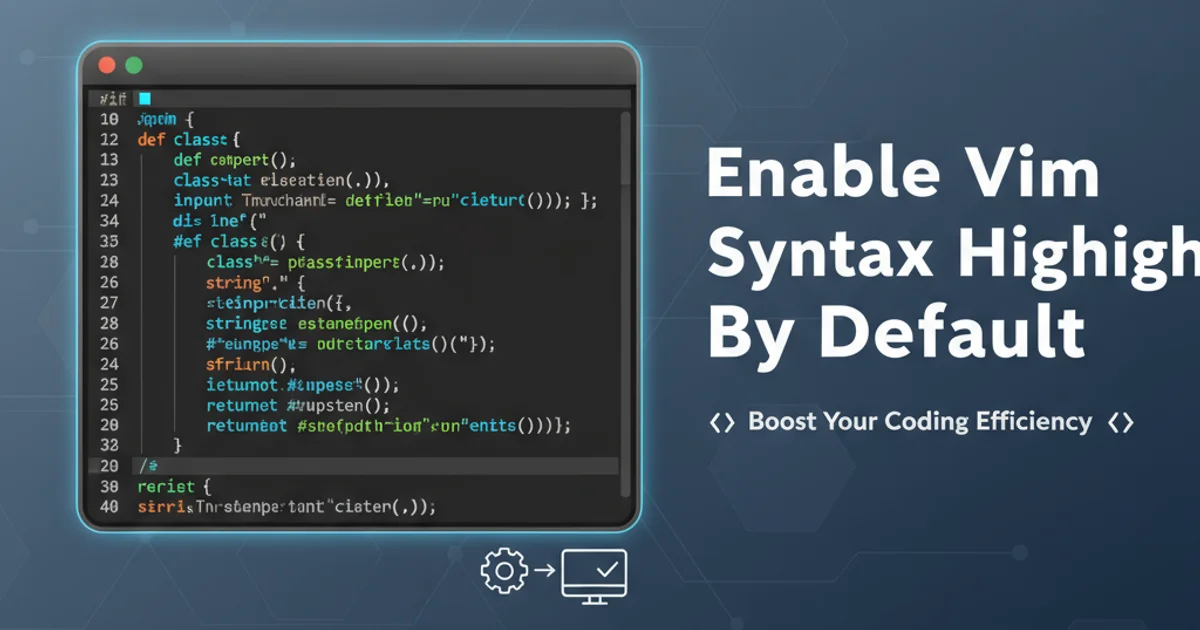Enable Vim Syntax Highlighting By Default
Categories:
Enable Vim Syntax Highlighting By Default

Learn how to configure Vim to automatically enable syntax highlighting for your code and text files, improving readability and coding efficiency.
Vim is a powerful text editor widely used by developers and system administrators. One of its most beloved features is syntax highlighting, which colorizes different elements of your code (keywords, strings, comments, etc.) to make it more readable and easier to understand. While Vim supports syntax highlighting, it's not always enabled by default. This article will guide you through the simple steps to ensure syntax highlighting is always active when you open a file in Vim.
Understanding Vim Configuration Files
Vim's behavior is controlled by configuration files, primarily .vimrc (or _vimrc on Windows). This file is executed every time Vim starts. By adding specific commands to your .vimrc file, you can customize Vim to suit your preferences, including enabling syntax highlighting. The .vimrc file is typically located in your user's home directory (~/.vimrc on Linux/macOS, or C:\Users\YourUser\_vimrc on Windows).
flowchart TD
A[Vim Startup] --> B{Check for .vimrc}
B -->|Found| C[Execute .vimrc commands]
B -->|Not Found| D[Load default settings]
C --> E{Syntax highlighting enabled?}
E -->|Yes| F[Display file with highlighting]
E -->|No| G[Display file without highlighting]
D --> GVim Startup Process and .vimrc Interaction
Enabling Syntax Highlighting Permanently
To enable syntax highlighting every time you launch Vim, you need to add a specific command to your .vimrc file. If you don't have a .vimrc file yet, you can simply create one in your home directory. The command syntax enable tells Vim to load the syntax files for the detected file type and apply the appropriate highlighting.
1. Open or Create Your .vimrc File
Open your terminal or command prompt and navigate to your home directory. Use Vim to open or create the .vimrc file. If it doesn't exist, Vim will create an empty file for you.
2. Add the 'syntax enable' Command
Once the .vimrc file is open in Vim, press i to enter insert mode. Add the line syntax enable to the file. You can place it anywhere, but it's common to put it near the top.
3. Save and Exit Vim
After adding the line, press Esc to exit insert mode, then type :wq and press Enter to save the file and quit Vim.
4. Verify Syntax Highlighting
Now, open any code file (e.g., a .js, .py, or .html file) with Vim. You should see the code displayed with syntax highlighting enabled.
" ~/.vimrc
" Enable syntax highlighting
syntax enable
" Optional: Set a color scheme (uncomment and change as desired)
" colorscheme desert
" Optional: Enable file type detection
filetype plugin indent on
Example .vimrc content to enable syntax highlighting
colorscheme <scheme_name> to your .vimrc. Vim comes with several built-in schemes like desert, molokai, ron, etc. You can also install custom color schemes.Troubleshooting and Advanced Options
Sometimes, syntax highlighting might not work as expected. This could be due to a misconfigured .vimrc or a missing syntax file for a particular language. You can check the status of syntax highlighting within Vim by typing :syntax on (to enable temporarily) or :syntax off (to disable temporarily). To see if syntax highlighting is currently active, use :echo has('syntax') which should return 1 if enabled.
:syntax on
:syntax off
:echo has('syntax')
Vim commands for temporary syntax control and status check
set t_Co=256 in your .vimrc.